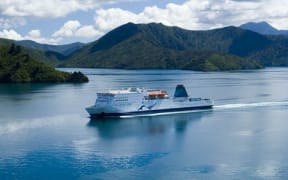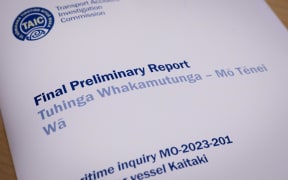A vital mechanical part that failed and left an Interislander ferry drifting toward rocks in high winds was 18 years old and should have been replaced years ago.
There were 864 people on board the Kaitaki when it lost power and issued a mayday before being blown toward the south coast during a storm in Wellington in late January.
The cause of the engine failure is still under investigation, but the Transport Accident Investigation Commission (TAIC) today released a preliminary report in the interests of safety.
One of the vessel's safety-critical rubber expansion joints had ruptured shortly after the engines failed, which prevented the engine from restarting.
Lorna Johnson was on the Kaitaki's 2.15pm sailing from Picton with her husband and two grandchildren.

The Kaitaki Photo: Supplied / KiwiRail
She remembers that day well.
"It's one thing to be at the evacuation area and it's quite another to be told to put your life jacket on, and at this point the ship wasn't moving forward but it was rocking a lot ... it was very very rough and a lot of people were ill," Johnson said.
"There was a couple of hours where we were just floating, and we started to see the shore coming up quite close."
The report from TAIC today found the rubber expansion joint, nestled in the engines high-temperature cooling water system, was too old to use - it had been on the shelf for 13 years before getting put to use in 2018.
Chief Commissioner Jane Meares said the manufacturer's advice was the joints should not exceed a shelf life of 8 months, and should be inspected annually and replaced every five years.

TAIC issued a preliminary report in the interests of safety Photo: Supplied
"Since the incident, KiwiRail has updated its guidance for the rubber expansion joints, but we believe that guidance still doesn't comply with the manufacturers guidance and doesn't account for the date of manufacture" Meares told media today.
KiwiRail, which operates the Interislander ferry service, accepted the joint was too old to be on the vessel and they did not have a process to pick up its manufacture date.
KiwiRail chief executive Peter Reidy said despite the joints having been reviewed every three months, they did not pick up the 2005 date.
It was however on the list to get replaced in March.
But he said they had taken precautions since the incident.
"We've actually checked all rubber joints on all our ships and as a precaution we've replaced all the safety critical joints with new products, and certainly our guidance now is 4 years shelf life and 4 years service life," Reidy told RNZ.
That goes against TAIC's recommendation to Maritime NZ of an 8 month shelf life, as recommended by the manufacturer of the joint that burst.
But KiwiRail said it has spoken to several of its manufacturers of the parts who all came back with different standard times - one as long as 10 years for its shelf life.
It had now replaced all its safety-critical joints with brand new pieces from a different manufacturer to the broken one.
Regardless, the commission recommended to Maritime NZ that it alert all vessel operators using the rubber pieces to take into account the date of manufacture.
Maritime NZ said it accepted the recommendations and has raised issues with maintenance both before and after the incident.
It was assessing the Interislander quality and safety management systems and expected that review to be completed in a few months.

